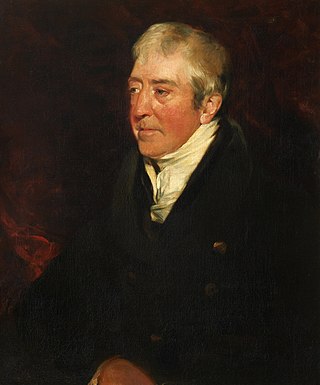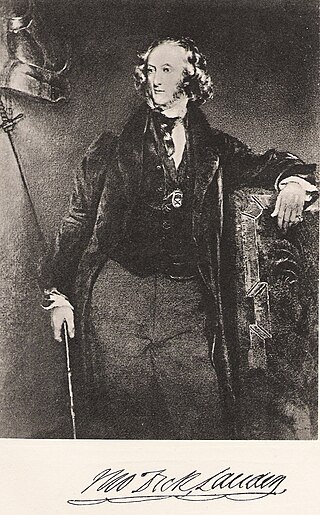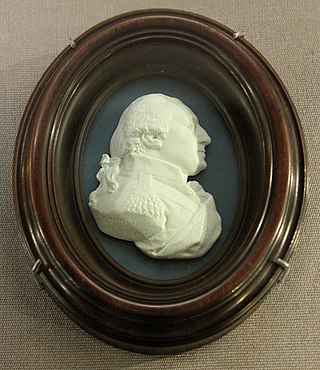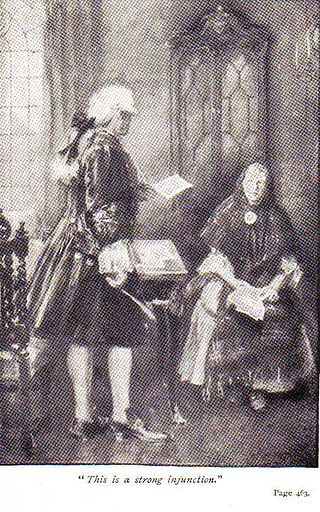Related Research Articles

Clan Campbell is a Highland Scottish clan, historically one of the largest and most powerful of the Highland clans. The Clan Campbell lands are in Argyll and within their lands lies Ben Cruachan. The chief of the clan became Earl of Argyll and later Duke of Argyll.

Dunoon is the main town on the Cowal peninsula in the south of Argyll and Bute, Scotland. It is located on the western shore of the upper Firth of Clyde, to the south of the Holy Loch and to the north of Innellan. As well as forming part of the council area of Argyll and Bute, Dunoon also has its own community council. Dunoon was a burgh until 1976.

Alexander Nasmyth was a Scottish portrait and landscape painter, a pupil of Allan Ramsay. He also undertook several architectural commissions.

Sir Thomas Dick Lauder of Fountainhall, 7th Baronet, FRSE FSA(Scot) LLD was a Scottish author. He served as Secretary to the Board of Manufactures (1839–), on the Herring Fisheries Board, at the Royal Institution for the Encouragement of the Fine Arts, and as Deputy Lieutenant of both counties of Moray and Haddington.

Colonel Sir John Sinclair, 1st Baronet, was a Scottish politician, military officer, planter and writer who was one of the first people to use the word "statistics" in the English language in his pioneering work, Statistical Accounts of Scotland, which was published in 21 volumes.

Clan MacDougall is a Highland Scottish clan, historically based in and around Argyll. The Lord Lyon King of Arms, the Scottish official with responsibility for regulating heraldry in Scotland, issuing new grants of coats of arms, and serving as the judge of the Court of the Lord Lyon, recognizes under Scottish law the Chief of Clan MacDougall. The MacDougall chiefs share a common ancestry with the chiefs of Clan Donald in descent from Somerled of the 12th century. In the 13th century the Clan MacDougall whose chiefs were the original Lords of Argyll and later Lords of Lorne was the most powerful clan in the Western Highlands. During the Wars of Scottish Independence the MacDougalls sided with the Clan Comyn whose chiefs rivaled Robert the Bruce for the Scottish Crown and this resulted in clan battles between the MacDougalls and Bruce. This marked the MacDougall's fall from power and led to the rise of their relatives, the Clan Donald, who had supported Bruce and also the rise to power of the Clan Campbell who were the habitual enemies of the MacDougalls and Clan Donald.

Sir Ilay Campbell, 1st Baronet, Lord Succoth, (1734–1823) was a Scottish advocate, judge and politician. He rose to be Lord President of the Court of Session.
John Thomas Wheatley, Baron Wheatley, was a Scottish Labour politician and judge.

Archibald Campbell Fraserof Lovat, was British consul at Tripoli and Algiers, and later colonel of the 1st Inverness local militia. Upon the death of his brother, Simon Fraser (1726–1782), Archibald became the 20th MacShimidh (chief) of Clan Fraser of Lovat, and sat in the House of Commons from 1782 to 1784.

Clan Maclachlan, also known as Clan Lachlan, Clann Lachainn (Argyll), and Clann Lachlainn, is a Highland Scottish clan that historically centred on the lands of Strathlachlan on Loch Fyne, Argyll on the west coast of Scotland. The clan claims descent from Lachlan Mor, who lived on Loch Fyne in the 13th century, and who has left his name upon the countryside he once controlled: places such as Strathlachlan, Castle Lachlan and Lachlan Bay. Tradition gives Lachlan Mor a descent from an Irish prince of the O'Neill dynasty, Ánrothán Ua Néill, son of Áed, son of Flaithbertach Ua Néill, King of Ailech and Cenél nEógain, died 1036. Clan Maclachlan has been associated with other clans, such as Clan Lamont, Clan Ewen of Otter, Clan MacNeil of Barra, and the MacSweens: as all claim descent from Anrothan O'Neill who left Ireland for Kintyre in the 11th century. From this descent the clan claims a further descent from the legendary Niall Noigíallach, High King of Ireland, who lived from the mid 4th century to the early 5th century.

Clan MacAulay, also spelt Macaulay or Macauley is a Scottish clan. The clan was historically centred on the lands of Ardincaple, which are today consumed by the little village of Rhu and burgh of Helensburgh in Argyll and Bute. The MacAulays of Ardincaple were located mainly in the traditional county of Dunbartonshire, which straddles the "Highland Line" between the Scottish Highlands and Lowlands. Clan MacAulay has been considered a "Highland clan" by writers and has been linked by various historians to the original Earls of Lennox and in later times to Clan Gregor. The MacAulays of Ardincaple, like Clan Gregor and several other clans, have traditionally been considered one of the seven clans which make up Siol Alpin. This group of clans were said to have claimed descent from Cináed mac Ailpín, King of the Picts, from whom later kings of Scotland traced their descent. The chiefs of Clan MacAulay were styled Laird of Ardincaple.

Carter-Campbell of Possil is a branch of Clan Campbell, a Scottish clan. Historically, they are part of Clan Campbell, which was regarded as one of the largest Scottish clans. The branch of the Campbell clan was historically centred in Lawers. Some of the clan, which originated with the original Campbells, had links to the lands of Argyll.
The Glenmasan manuscript is a late 15th-century Gaelic vellum manuscript in the National Library of Scotland, Edinburgh, where it is catalogued as Adv.MS.72.2.3. It was previously held in the Advocates Library, Edinburgh, where it was classified as Gaelic MS LIII, and transferred to the National Library of Scotland on its foundation in 1925. The compilation contains Scottish Gaelic literary versions of tales of the Ulster Cycle, such as the Táin Bó Flidhais and Oided mac nUisnig.
The Militia of Great Britain were the principal military reserve forces of the Kingdom of Great Britain during the 18th century.
Robert Beatson, LL.D. FRSE FSA (1741–1818) was a Scottish compiler and miscellaneous writer.

Walter Frederick Campbell of Shawfield (1798–1855), was a Scottish politician. He served as the MP for Argyllshire, 1822–1832 and 1835–1841.

Jeanie Deans is a fictional character in Sir Walter Scott's novel The Heart of Midlothian first published in 1818. She was one of Scott's most celebrated characters during the 19th century; she was renowned as an example of an honest, upright, sincere, highly religious person. The name "Jeanie Deans" was given to several pubs, ships, railway locomotives, an opera, a play, a poem, a song, a hybrid rose, an antipodean potato, and a geriatric unit in a hospital. They all take their name from Scott's heroine. There was also a so-called Jeanie Deans' Cottage in Edinburgh. It was demolished in 1965.
Dubhghall mac Suibhne was a Scottish landholder in Argyll, and a leading member of Clann Suibhne. He was a son of Suibhne mac Duinn Shléibhe, and appears to have held lordship of Knapdale from at least the 1240s to the 1260s, and may have initiated the construction of Skipness Castle and Lochranza Castle.
The Sheriff of Caithness was historically the royal official responsible for enforcing law and order in Caithness, Scotland.

Duncan Forbes of Culloden was a Scottish lawyer and Whig politician who sat in the House of Commons from 1721 to 1737. As Lord President and senior Scottish legal officer, he played a major role in helping the government suppress the 1745 Jacobite Rising.
References
- ↑ "The Society's Foundation". The Royal Highland and Agricultural Society of Scotland. Archived from the original on 18 October 2011. Retrieved 18 September 2010.
- ↑ Scottish Garden Buildings by Tim Buxbaum p.15
- ↑ Grant's Old and New Edinburgh vol.2 p.294
- ↑ Grant's Old and New Edinburgh vol.2 p.294
- ↑ Grant's Old and New Edinburgh vol.2 p.295